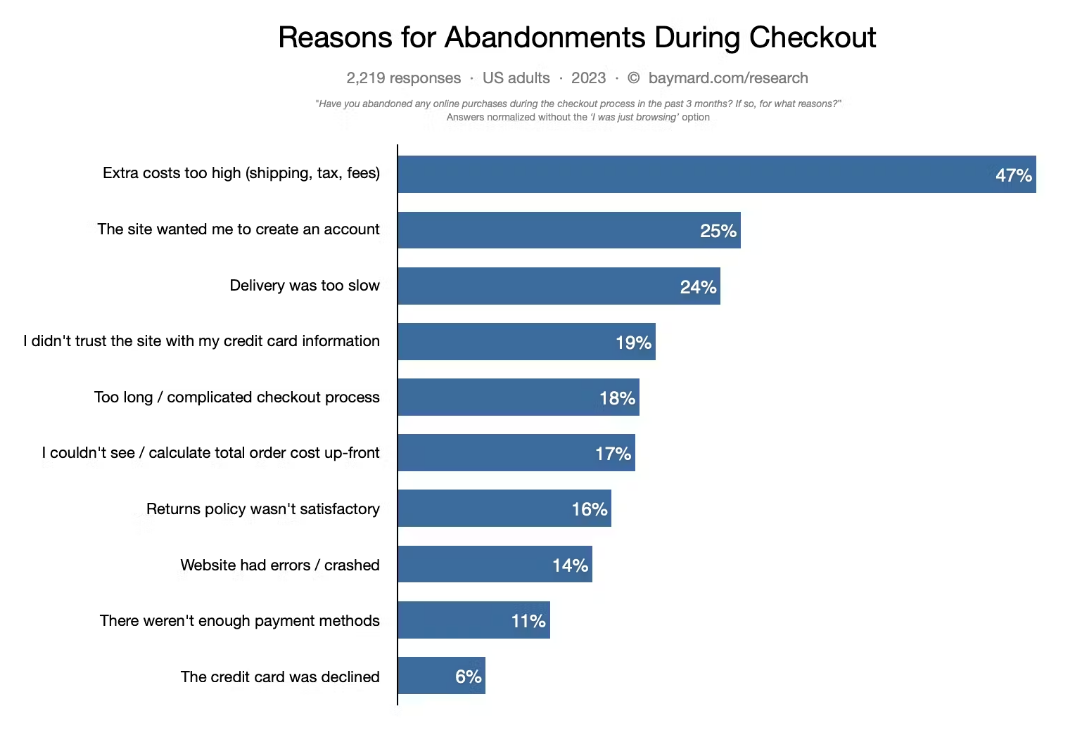7 Strategies to Combat Abandoned Carts
In ecommerce, there exists a challenge that plagues many businesses: abandoned carts. These seemingly innocuous digital shopping carts left behind by customers contain unrealized revenue and untapped potential. Understanding why customers abandon their carts and implementing effective strategies to re-engage them is a pivotal aspect of successful ecommerce operations.
Understanding Cart Abandonment
Cart abandonment is both a pain point and an opportunity for online retailers. Studies suggest that nearly 70% of online shopping carts are abandoned before the completion of a transaction (Baymard). While it’s a common occurrence, the reasons behind it can vary widely.

Factors Contributing to Cart Abandonment
1. Unexpected Costs
Additional charges such as shipping fees or taxes can deter customers at the checkout stage. It’s important to A/B test showing this info higher up in the funnel so visitors are aware of this information before heading to the cart.
2. Complicated Checkout Process
Lengthy or complex forms and mandatory account creation can lead to frustration and abandonment. Determine which checkout design is best for your customers: multi-step, one-page, etc. Sometimes a long checkout process can be skipped altogether with express payment options presented in the cart or beginning of checkout like Shopify’s ShopPay, PayPal or ApplePay. It’s important to do research on the checkout to see where visitors might be experiencing friction or getting stuck.
3. Security Concerns
Lack of trust in the payment process or website security can prompt customers to abandon their carts. Does your checkout design appear trustworthy? Is your checkout utilizing secure techniques to safeguard users’ details? If so, make that known.
4. Distractions or Indecision
Customers might leave without completing the purchase due to distractions or simply changing their minds. Presenting cross-sells in the checkout, for example, could be a good place to try and increase AOV, but it could also be taking visitors out of the purchase process.
5. Comparison Shopping
Some customers use the cart to compare prices or products across different websites. That means you’ll need to counter their objections and/or questions before the checkout. In doing research on your site, you should also be querying your customers and visitors about what competitors they’re also looking at and why. You can then find ways to promote your store by mentioning why you’re better than competitor sites.
7 Strategies to Combat Cart Abandonment
1. Email Remarketing
One of the most common strategies is to leverage email remarketing. Sending personalized follow-up emails reminding customers about their abandoned items can be effective. This is a must-have for all ecommerce stores. Additionally, offering incentives like discounts or free shipping can motivate them to complete the purchase.
2. Retargeting Ads
Retargeting ads on social media or other platforms can reignite the interest of potential customers. Visual reminders can be compelling, but there’s a risk of ad fatigue or customers finding it intrusive if not executed tactfully, be careful with this approach.
3. Exit-Intent Pop-ups
Implementing exit-intent pop-ups can intercept customers before they leave the site. Offering last-minute deals or reminders can encourage them to reconsider their decision. Many tools offer the ability to target certain segments of your audience, so you can present those that viewed the cart or checkout but didn’t purchase with a deal that’s too good to pass up.
4. Simplified Checkout Process
Streamlining the checkout process by offering guest checkout or one-click purchasing with express payment options like PayPal or ShopPay can significantly reduce friction and increase completion rates.
5. Cart Recovery Tools
Automated cart recovery tools can identify and send reminders to customers who abandon their carts. Some tools even allow for personalized follow-ups.
6. Customer Support Follow-Up
Engaging customers directly through customer support can uncover reasons for abandonment and provide tailored solutions. While this approach can build customer loyalty, it might not be scalable for large volumes of abandoned carts. There are some services that offer this, if you don’t have a support team or a large enough team to effectively manage abandoned carts.
7. A/B Testing and Optimization
Constantly testing different strategies and optimizing based on the results can be highly effective. It requires time and resources for analysis and implementation, but can be worthwhile to invest in.
Conclusion
By understanding the diverse reasons behind abandoned carts and employing a strategic mix of email remarketing, retargeting ads, simplified checkout processes, and customer engagement, your store can significantly reduce cart abandonment rates and boost conversions.
An abandoned cart can be a symptom of other issues on the site, so it’s important to dig into this number and try to figure out the why’s. Although you may want to jump right into changing the checkout, a high abandoned cart rate could mean optimizing other areas of the site to inform visitors of key information like shipping costs, return policies and more that might come up during their purchase decision.

